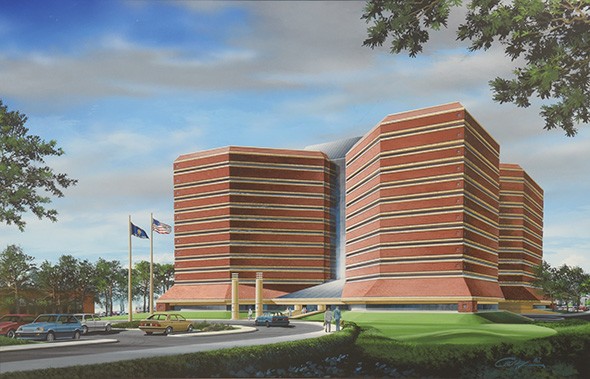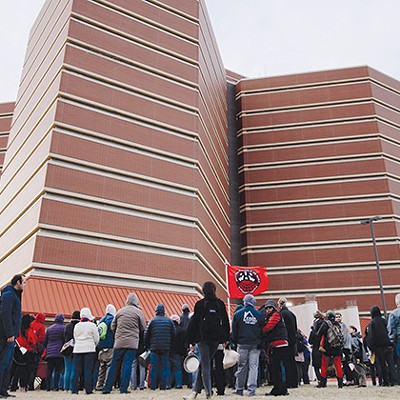
In 1991, a ribbon-cutting ceremony was held at the corner of Robert S. Kerr and Shartel avenues in downtown Oklahoma City. The occasion marked the opening of Oklahoma County Detention Center. The jail was designed by architects HTB Inc. and RGDC Inc., and completed sooner than expected.
However, what was unknown to onlookers at the time was that the jail’s architects had never designed a jail before and finishing construction ahead of schedule meant overlooking safety precautions and ignoring recommendations from county commissioners.
A 2008 report filed by U.S. Department of Justice’s (DOJ) Civil Rights Division indicated that corners might have been cut to lower costs. The report states that based on design alone, the jail at 201 N. Shartel Ave. is not equipped to safely house individuals, much less ensure that there is no chance of their escape.
Left to stand the test of time for 27 years, experts now agree that incidents of jail violence, death, escapes and abuse prove the report’s findings true and despite uncertainty over whether or not county residents would agree to pay for a new jail, recently elected Oklahoma District 1 county commissioner Carrie Blumert said it is time to put the idea back on the table.
“I think if the public was more aware of the issues that surround the jail right now, they would be open to the idea,” Blumert said.
Because funds for a new county jail would likely need to be paid through property taxes, the ultimate decision would be left to taxpayers to decide through a ballot measure.
Educating the public on why a new county jail is needed, Blumert said, is the first step to making it a reality.
Taking note
After inspecting the jail four times, correctional practice experts with DOJ composed a 24-page report listing potentially hazardous flaws and correlating recommendations.
Experts reported that several factors combined to create a dangerous situation at the jail, including “the lack of adequate detention staff … the overcrowded conditions … and little interaction between detention officers and detainees.”
Likewise, the report stated “the large number of detainees, combined with the awkward physical layout of the Jail, makes providing adequate sight and sound supervision of detainees in their housing units extremely difficult.”
"Everybody wants to create a new jail; the issue is how we pay for it."
tweet this
—Mark Opgrande
Standing 13 floors high and designed to house 1,250 inmates, the jail continues to be overcrowded with around 1,700 inmates who are undoubtedly affected by the limited space, Oklahoma County Sheriff’s Office spokesman Mark Opgrande said.
“Other than one small common space, there’s no recreational room in the jail besides a small basketball court on the roof of the building,” Opgrande said. “But there’s no way 1,700 inmates can fit out there at once, so many don’t get the opportunity to get out of their cells often in a 24-hour period.”
While access to medical care is a constitutional right for prisoners, the jail was not built with a medical unit and, until recently, went without one. The current medical unit is located on the jail’s 13th floor, Opgrande said, and consists of old jail cells that have been converted into doctor and counselor offices.
The DOJ report tied the jail’s issues with several disturbing occurrences that took place during the time the jail was studied, including an incident in which a woman detainee who was in premature labor three months early was left handcuffed to a wall for 10 hours with no medical treatment or help despite crying out for it. The infant died shortly after it was born.
The report also conveys how the suicides of several inmates remained unnoticed for hours at a time.
In September, more than 30 inmates escaped their jail cells in an attempt to riot. In 2017, 12 inmates died within the jail’s premises. Since it opened, Oklahoma County Detention Center has been sued numerous times.
New life
With the criminal justice community in Oklahoma County nearly in agreement that a new county jail would be preferable to renovation, Blumert said she will do her due diligence to educate the public on the issues but leave the final decision to them.
This year saw the formation of Greater Oklahoma City Chamber’s Criminal Justice Task Force, designed to independently assess and resolve issues in county jails across the state.
After a one-year assessment period, the task force issued six recommendations that could ease problems within Oklahoma County Detention Center. Those recommendations include keeping people charged with lower-level offenses out of jail entirely and creating alternatives to jail for people with mental illness or substance abuse disorders.
While the task force has not publicly issued a recommendation for the creation of a new jail, several studies have been issued to assess whether or not such a creation would be beneficial.
“Everybody wants to create a new jail,” Opgrande said. “The issue is how we pay for it.”
In 2013, commissioners nearly put a $281 million jail proposal before county voters but withdrew the idea before ballots could be printed.
“All things are possible, and it’s never too late,” District 1 county commissioner Willa Johnson said. “We can spend a lot of money repairing a jail that can’t be fixed, or we can build a new one. I hope we get a new jail that’s safe for the inmates and for those who work with them. There’s only so much patching up we can do to the one we have now.”
Blumert will replace Johnson in January when Johnson retires after serving 25 years in public office, 10 of which were as county commissioner. She said she knows she’s leaving her district in good hands and that it might be time to breath new life into an old issue.











